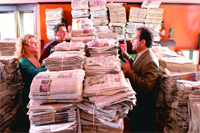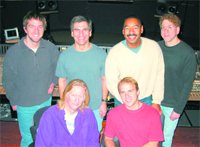HOLLYWOOD - Next month the USA Network series Monk, starring Tony Shalhoub as the obsessive compulsive detective Adrian Monk, begins production on season three, entering it's second season of HD post production and 5.1 sound mixes. "The best part of it," says Monk post producer Scott Collins (Alias, NYPD Blue), "is the end result - knowing that we're delivering the best looking and best sounding show possible."
Monk was the inspiration of veteran producer David Hoberman (Bringing Down the House, Moonlight Mile). "ABC was looking for an Inspector Clouseau kind of detective show," notes Hoberman. "I had this idea of someone who was messed up and brilliant at the same time."

Season two saw the first Monk episode that was both posted and broadcast in high definition.
|
Hoberman enlisted writer/producer Andy Breckman (Rat Race, Late Night with David Letterman) to pen the pilot script. "Monk combines two of my passions," says Breckman, "mystery writing and comedy. Colombo and Seinfeld are two of my favorite shows. We try to make each show a combination of Colombo, Seinfeld and Sherlock Holmes."
The pilot, "Mr. Monk and the Candidate," was helmed by Academy Award-winning director Dean Parisot. "The pilot was a strong collaboration between myself, David Hoberman, Andy Breckman and Tony Shalhoub. Tony and I had worked together on [the feature] Galaxy Quest and are good friends."
The 79-minute pilot was shot in 35mm, but when the series got picked up by USA Network, production switched to Super 16mm for budget reasons. Season one was shot and posted in Toronto.
Production and post moved to Los Angeles for Monk's second, 16- episode season, "because nobody wanted to go back to Toronto and we thought we could make a better show here," explains Hoberman.
Monk's production offices and offline editorial are now based at Ren-Mar Studios (www. renmarstudios.com) in Hollywood. All 29 episodes have been shot Super 16mm with two Arriflex 16SR cameras using mostly Kodak Vision 7279. Film-to-tape transfer and online post is done at Encore Hollywood (www.encorehollywood).
THE POST
Monk shoots mostly on location, and DP Tony Palmeri says he's using post now more than ever before. What he means is that in his head he sees a shot on the screen and knows he can create a look later when he's color correcting rather than spend a few more hours hanging lights.

The Monk team (L-R): Kevin Roache, Elmo Ponsdomenech, Joe Earle, Ron Rosen, (bottom) Bob Newlan and Scott Collins.
|
Encore's Spirit DataCine turns all the footage into a Panasonic D-5 master and Betacam dailies that get sent over to Monk editorial at Ren-Mar. Monk uses three Avid Media Composers for offline post, two for the editors and one for the assistant editor to upload footage.
Monk's distinguished list of editors include Joe D'Augustine (The Invisible Man), Michael Matzdorff (Control Factor), Ron Rosen (Six Feet Under), Craig Webster (The Circle) and Richard Wells (La Femme Nikita).
Rosen says because they shoot two cameras he often gets three and a half hours of dailies a day. And it's a rigorous schedule, he continues, where multiple episodes are in production and post at the same time. One time, he recalls, he worked on four different episodes in one day.
Stylistically Rosen explains they try to, "always play the comedy. It's all about being funny, even if you are going about the business of solving a serious murder." If Monk gets hung up on some obsessive-compulsive bit of business, he says, they stop the story momentum a bit and stretch out that moment to make the audience a little uncomfortable. "Andy [Breckman] loves those moments," notes Rosen.
Encore colorist Pankaj Bajpai says to get a good quality HD master from Super 16 you have to start at the beginning and make sure your exposure is correct. He says, "35mm is much more forgiving."
The real challenge, he continues, is controlling the grain. They make two passes from the Super 16mm negative. The HD pass is minimally processed - no noise reduction or crushing of blacks. That HD master is not used until final assembly. The NTSC dailies are a 3/4 extraction downstream from the HD signal and are given basic color correction so they don't look washed out. Bajpai says that during final color correction he spends a lot of time with the DPs and post supervisor getting the look just right.
THE AUDIO POST
Audio post on Monk is done at Technicolor Sound Services (www.technicolor. com). Scott Collins notes that the simplified audio post production took some getting used to after the dense multilayered audio imagery he was producing while working on NYPD Blue. "The show is very dialogue driven. There is plenty of music but when it comes to sound effects and background effects we play them way down in order to let the comedic performances play through."